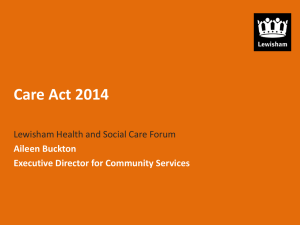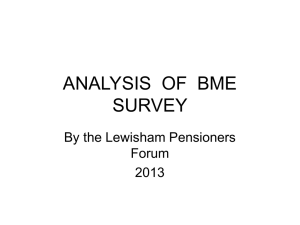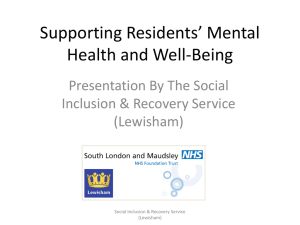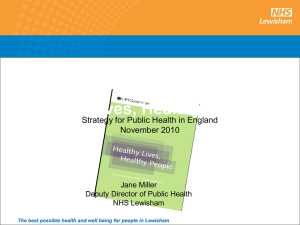Topic Summary
advertisement
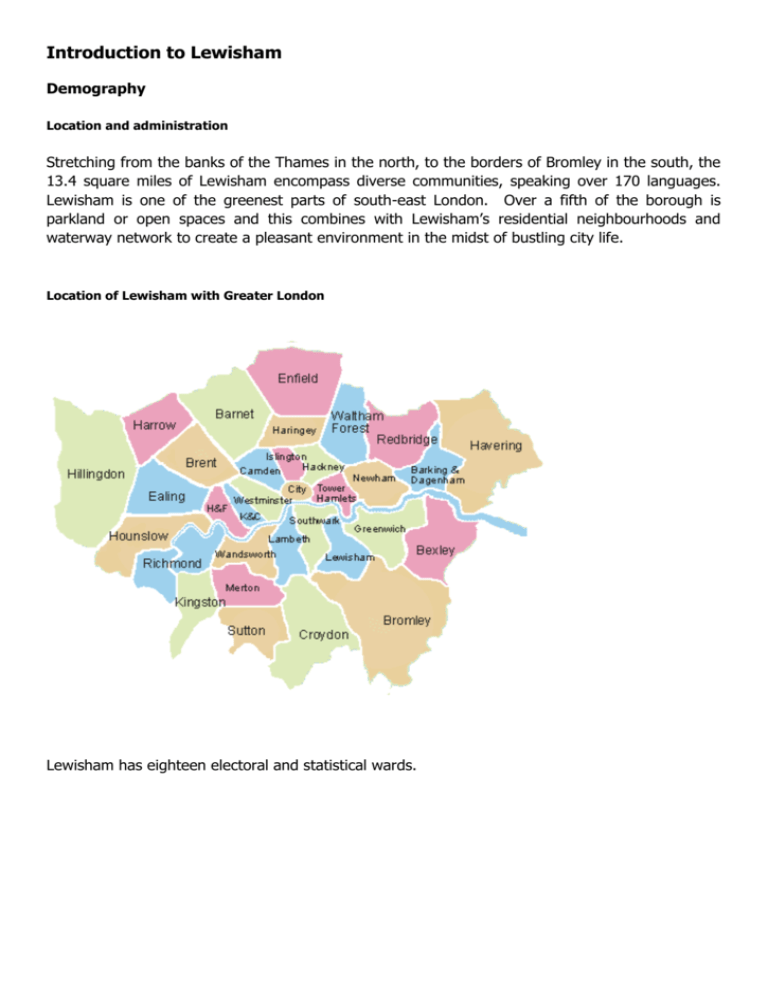
Introduction to Lewisham Demography Location and administration Stretching from the banks of the Thames in the north, to the borders of Bromley in the south, the 13.4 square miles of Lewisham encompass diverse communities, speaking over 170 languages. Lewisham is one of the greenest parts of south-east London. Over a fifth of the borough is parkland or open spaces and this combines with Lewisham’s residential neighbourhoods and waterway network to create a pleasant environment in the midst of bustling city life. Location of Lewisham with Greater London Lewisham has eighteen electoral and statistical wards. Lewisham’s ward boundaries Demography Population of Lewisham Lewisham’s population of about 284,000 people is relatively young, with one in four residents aged under 19 years. The population aged 60 years and over represents one in eight people in the borough. This contrasts with England as a whole, where more between one in four and one in five people is over 60. Males comprise 49% of Lewisham’s population, females 51%. These proportions are not expected to change in the next few years. Population Pyramid, Lewisham and England (based on GLA Round 2012 London Plan projections for Lewisham for mid-2013, and ONS 2001 Census for England). Population projection pyramid, annual percentage of males and females by single year of age, Lewisham mid 2013 and and England 2011 census 91 86 81 76 71 England Males England Females 66 61 56 51 46 41 36 Lewisham Males 31 Lewisham Females 26 21 16 11 6 1 2.0% 1.5% 1.0% 0.5% 0.0% 0.5% 1.0% 1.5% 2.0% Trends Between 2001 and 2011, the population of Lewisham grew by 17,000, or 10%, and has grown by a further 9,000 between 2011 and 2013. Between 2013 and 2018 the population is expected to grow by a further 15,000, or 5%. The highest growth is expected in Lewisham Central (16.6%), Rushey Green (12.4%), New Cross (12.4%) and Evelyn (10.9%) wards. Projected age-band changes by ward in Lewisham 2013-2018 25,000 20,000 15,000 e >75 d 65-75 c 45-64 10,000 b 15-44 5,000 a 0-14 0 2013 2018 2013 2018 2013 2018 2013 2018 2013 2018 2013 2018 2013 2018 2013 2018 2013 2018 2013 2018 2013 2018 2013 2018 2013 2018 2013 2018 2013 2018 2013 2018 2013 2018 2013 2018 Bellingham Blackheath Brockley Catford South Crofton Park Downham Evelyn Forest Hill Grove Park Ladywell Lee Green Lewisham Central New Cross Perry Vale Rushey Green Sydenham Telegraph Hill Whitefoot Projected change in ward populations 2013-2018 22000 Lewisham Central 21000 20000 Evelyn 19000 Brockley New Cross 18000 Rushey Green Telegraph Hill 17000 Sydenham Perry Vale 16000 Catford South Bellingham Whitefoot Blackheath Ladywell Grove Park Lee Green Crofton Park 15000 14000 2013 2018 Births Live births to Lewisham residents have risen annually in the last few years, and this is expected to continue, though at a slower rate. The following table shows the live births registered1 and the annual figures to 2018 as estimated by the Greater London Authority2. Year 2008 2009 2010 2011 2012 2013 2014 2015 2016 2017 2018 Annual Births, Lewisham residents Registered GLA projections births (Round 2012) 4872 4776 4975 5019 4919 5043 5119 5148 5168 5146 5117 Between April 2008 and March 2009 there were 4744 NHS delivery episodes for women resident in Lewisham3. Around 46% of births were to women from black and minority ethnic groups, and the ethnicity of a further 15% is not known. 5% of deliveries were to women aged under 20, and 6% were to women aged over 40. At the time of writing more recent data is not available, but data is available on babies born4. Between April 2011 and March 2012 the majority of babies born to Lewisham women were born in University Hospital Lewisham (UHL), but there is clear effect of proximity on choice of provider hospital. Women who live in North Lewisham (Brockley, Evelyn, New Cross and Telegraph Hill wards) tended to choose St Thomas’s Hospital, and a large proportion of women from Crofton Park, Forest Hill, Perry Vale, Telegraph Hill and Sydenham gave birth at King’s College Hospital (KCH). A smaller number of women, mostly from South Lewisham (Downham, Bellingham, Grove Park, and Whitefoot wards) and Blackheath gave birth at South London Hospitals. The following chart shows how the percentage of each ward’s births were made up. 1 2 3 4 From Office of National Statistics GLA Round 2012 standard fertility projections Source: Lewisham Secondary User Service (SUS) database Source: ONS Public Health Birth Files Lewisham residents hospital of birth by mother's ward of residence 2011-12 100% Others/home Princess Royal Hospital Queen Elizabeth Hospital 90% St Thomas's Hospital 80% 70% King's College Hospital 60% 50% 40% Lewisham Hospital 30% 20% 10% 0% Deaths The number of registered deaths of Lewisham residents fluctuates from year to year, and but there has been a steady reduction in the last few years. The following table shows the registered deaths recorded in the Primary Care Mortality Database5 and the annual figures to 2015 as estimated by the Greater London Authority6. Annual Deaths, Lewisham residents Year Registered deaths 2008 2009 2010 2011 2012 2013 2014 2015 2016 2017 2018 1776 1701 1614 1601 GLA projections 1556 1684 1649 1621 1596 1574 1553 The main underlying causes of death in Lewisham are cancer, circulatory diseases, and respiratory diseases. The following charts illustrate the breakdown of causes of death in calendar year September 2011 to August 2012, the most recent 12 months period for which full data is available at the time of writing, first by broad category of cause, and second with a more detailed breakdown. 5 6 From Office of National Statistics & HSCIC GLA Round 2012 standard fertility projections Deaths of Lewisham Residents by broad cause of death September 2011 to August 2012 Source: ONS/NHSICPCMD Dementia 10% Cancer 30% Respiratory 13% All others (inc unknown) 19% Circulatory 28% Main underlying causes of death, Lewisham residents, September 2011 to August 2012 Source ONS/NHSIC PCMD All other causes 24% Cancer 30% cancer, breast 2% other, infection UTI 2% other 15% cancer, digestive 7% cancer, lung 7% other, infection not UTI 1% cancer, prostate 2% other, diabetes 1% other, dementia 10% respiratory disease, other 1% Respiratory diseases 14% respiratory, pneumonia 6% cancer, other 11% circulatory, IHD not AMI 9% circulatory, AMI 4% respiratory, COPD 6% circulatory, circulatory, other stroke 8% 7% Circulatory diseases 28% Until 2011 circulatory diseases were the largest contributor, but in 2011 these fell below the number of cancer deaths for the first time. This appears to be partly a result of fall in deaths from circulatory disease themselves, continuing an underlying trend, and an anomalously high number of deaths from cancer in 2011. The following chart shows the number of deaths from 2005 to 2011 by underlying cause. Deaths of Lewisham residents by underlying cause of death 2005-2011 700 600 500 Cancer 400 Circulatory All others 300 200 Respiratory 100 Dementia 0 2005 2006 2007 2008 2009 2010 2011 Deaths from underlying dementia more than doubled in 2011, and continued to rise in the part of 2012 for which data is available. It is not clear whether this is a genuine change, a matter of natural variation, or related to changes in clinically coding causes of death. Ethnic diversity Lewisham is the 15th most ethnically diverse local authority in England, and two out of every five residents are from a black and minority ethnic background. The largest BME groups are Black Caribbean and Black African: Black ethnic groups are estimated to comprise 30% of the total population of Lewisham. Overall ethnic make-up of Lewisham The following charts show the estimated ethnic make-up of Lewisham’s population in 2013 according to the GLA’s Round 2011 projections. These use the GLA’s Aggregated Ethnic Group classification, in which mixed White and any Black ethnicity counts as Black Other, and mixed White and any Asian ethnicity counts as Other Asian. Lewisham's population 2013, by broad ethnic group Source GLA Round 2011 EGPP Chinese 1% Bangladeshi 1% Pakistani 1% Other Asian 3% Other 3% Indian 2% Black Other 6% Black Caribbean 13% White 59% Black African 11% The age profile of the BME groups is younger than that of the White groups. Age breakdown by broad ethnic group Lewisham's population 2013 Age-breakdown by broad ethnic group, persons source: GLA Round 2011 EGPP e 75+ 100% d 65-74 90% c 45-64 80% 70% 60% b 15-44 50% 40% 30% 20% a 0-14 10% 0% All Ethnicities White Black African Black Caribbean Black Other Indian Pakistani Bangladeshi Chinese Other Asian Other One in five of the overall population is under 15, but this is doubled in the Bangladeshi group, and more than more than doubled in the Black Other group. The under 15 proportion is lowest in the White and Chinese groups. The proportion in the over-65 group is highest in the White, Black Caribbean, Indian, and Chinese groups. The following charts show how the expected population of each ethnic group is expected to change from 2013 to 2018 All ethnicities 200,000 2013 All ethnicities 2014 2015 2016 2017 2018 200,000 2013 150,000 150,000 100,000 100,000 50,000 50,000 0 b 15-44 c 45-64 d 65-74 e 75+ All BME 2016 2017 2018 a 0-14 b 15-44 c 45-64 d 65-74 e 75+ Black Caribbean 2013 2014 2015 2016 2017 2018 20,000 60,000 15,000 40,000 10,000 20,000 5,000 0 2013 2014 2015 2016 2017 2018 0 a 0-14 b 15-44 c 45-64 d 65-74 e 75+ Black African 20,000 2015 0 a 0-14 80,000 2014 2013 a 0-14 b 15-44 c 45-64 d 65-74 e 75+ Black Other 2014 2015 2016 2017 2018 10,000 2013 2014 2015 2016 2017 2018 8,000 15,000 6,000 10,000 4,000 5,000 2,000 0 0 a 0-14 b 15-44 c 45-64 d 65-74 e 75+ Bangladeshi 800 2013 a 0-14 b 15-44 c 45-64 d 65-74 e 75+ Indian 2014 2015 2016 2017 2018 600 4,000 2013 2014 2015 a 0-14 b 15-44 2016 2017 2018 3,000 400 2,000 200 1,000 0 0 a 0-14 b 15-44 c 45-64 d 65-74 e 75+ Pakistani 1,000 c 45-64 d 65-74 e 75+ Chinese 2013 2,500 2014 2013 2014 2015 a 0-14 b 15-44 2016 2017 2018 2,000 1,500 500 1,000 500 0 0 a 0-14 b 15-44 c 45-64 d 65-74 e 75+ 2013 d 65-74 e 75+ Other Other Asian 4,000 c 45-64 2014 2015 2016 2017 2018 5,000 2013 2014 a 0-14 b 15-44 2015 2016 2017 2018 4,000 3,000 3,000 2,000 2,000 1,000 1,000 0 0 a 0-14 b 15-44 c 45-64 d 65-74 e 75+ c 45-64 d 65-74 e 75+ Ethnicity in schoolchildren In 2008/09 there were 35,062 pupils enrolled in Lewisham’s 91 schools, 61% of whom were from black and minority ethnic (BME) communities (3% not known). This percentage of BME pupils is significantly different from the proportion within the resident population. This could be interpreted as an indication of the future ethnic make-up of Lewisham’s adult population, knowledge that could assist in planning services for both the current population aged under 18 years and future adult service users. However, it must be noted that some areas of the borough have a highly mobile population and some pupils attending Lewisham schools may not reside in the borough. As such, this information cannot be used as the sole basis of predicting future need. Pupils with Lewisham post code by school type, 2009 No. Pupils with % Pupils with School Type Total No of Pupils Lewisham Post Code Lewisham Post Code 231 220 95.2 Nursery Primary 21464 19776 92.1 Secondary 10332 8766 84.8 595 548 92.1 Special 7 Migration Data from the Population Estimates Unit at the Office of National Statistics8 show that from 20034 to 2009-10 there was an annual average net outflow from Lewisham of about 700 people, made up of 1950 net international migrants into the borough, and 2660 internal migrants outwards. International migration appears to have peaked in 2004-5, and declined until 2008-9; internal migration fell every year until 2008-9. Migration into and out of Lewisham 2003-4 to 2009-10 4000 3000 2000 flow into Lewisham International 1000 0 -1000 -2000 2003-4 2004-5 2005-6 2006-7 2007-8 flow out of Lewisham -3000 -4000 -5000 7 8 Source: Lewisham School Census, January 2009 http://www.statistics.gov.uk/statbase/product.asp?vlnk=15239 2008-9 2009-10 Overall flow Internal Accurate figures for the total number of international migrants are difficult to ascertain. According to the Department for Work and Pensions9, a total of 8,020 non-UK nationals resident in Lewisham were issued with new National Insurance numbers in 2011. This figure has generally increased, and in 2011 was 60% higher than in 2004. National Insurance Numbers issued to migrants 2004 to 2011 9 900 8 Lewisham 800 7 700 England 600 6 Lewisham (000) 5 500 England 4 400 3 300 2 200 1 100 0 (000) 0 2004 2005 2006 2007 2008 2009 2010 2011 Although these figures give us an indication of levels of international migration, they do not include (a) their dependants or (b) those working without National Insurance numbers. The numbers of asylum seekers have been steadily declining in recent years in line with national trends. As at the end of December 2009, 35 asylum seekers in Lewisham were receiving support for accommodation and 115 people were receiving subsistence support from the National Asylum Support Service10. We are aware that there are many people who because they have no recourse to public funds or for other reasons linked to their immigration status are not included in any official statistics. Short term migrants Short term migrants are defined as people resident in an area for between three and nine months, for whatever reason. A research report published by ONS11 estimates that at mid-year 2007 there were 11,480 short term migrants in Lewisham, for whom 1,510 were workers, and 9,980 were non-workers. This represented about 4% of the overall population. Religion and Belief Christianity was the most common religion in Lewisham at the time of the 2011 Census (53%), followed by Islam (6%). About 27% of people stated they had no religion and 9% did not state their religion or belief. http://www.statistics.gov.uk/statbase/product.asp?vlnk=15239 http://rds.homeoffice.gov.uk/rds/immigration-asylum-stats.html 11 Summarised in GLA DMAG Briefing 12-2009 9 10 Religious Profile of Lewisham12 Religion Christian Buddhist Hindu Jewish Muslim Sikh Other religion No religion Religion not stated Lewisham % 52.8 1.3 2.4 0.2 6.4 0.2 0.5 27.2 8.9 London % 48.4 1 5 1.8 12.4 1.5 0.6 20.7 8.5 England % 59.4 0.5 1.5 0.5 5 0.8 0.4 24.7 7.2 Disability There is no one official statistic for disability. In Lewisham Council’s 2007 Residents Survey, of the 1,042 people surveyed, 14% of respondents described themselves as disabled. In the 2011 Census, 15.6% of Lewisham residents were classed as not in good health. In the ONS Annual Population survey data for 2007 14.2% of people of working age were categorised as disabled. Sexual Orientation There are no accurate statistics available regarding the profile of the lesbian, gay, bisexual and transgender (LGBT) population either in Lewisham, London or Britain as a whole. Sexuality is not incorporated into the census or most other official statistics. The Greater London Authority based its Sexual Orientation Equality Scheme on an estimate that the lesbian and gay population comprises roughly 10% of the total population. This would make the lesbian and gay population of the borough roughly 20,000, although whether this includes bisexual or transgender individuals is unclear. About 0.4% of Lewisham households comprise same sex couples in civil partnerships (Census 2011). This is more than double the average for England. 12 Source: 2011 Census
